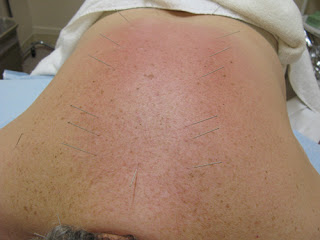Different types of shoulder injuries will require different types of treatments. While it may be in your best interest to try natural healing options for certain conditions, surgery may be the best suited option in other cases. It is estimated that the average time it takes to recover from shoulder surgery (regaining 75-80% of strength and function) is 6-7 months. In some cases it may take up to a year, with complete recovery taking as long as 2 years. This all depends on the initial health of the individual, the extent of the injury, quality and commitment to rehabilitation, the patient's diet and modalities of rehabilitation. Using acupuncture and Chinese herbs can shorten your recovery time in each of the phases of rehabilitation.
It is possible to get the strength and function of your shoulder back sooner, reduce the pain of the trauma from the surgery, decrease scar tissue and minimize the loss of range of motion, all by using acupuncture and Chinese herbal formulas.
Possible shoulder injuries or conditions are fractures, dislocation/subluxation, tears, impingement, tendinitis, bone spurs and bursitis. Obviously, not all of these conditions will require surgery. For the sake of this article the focus is on injuries and shoulder surgeries such as, arthroscopic, rotator cuff repair, Bankart surgery and prosthetic shoulder replacement. All of these surgeries can be greatly beneficial to the patient, but they can also cause great trauma to the area that takes a long time to heal and lots of dedication and time in physical rehabilitation by the patient.
There are certain risks associated with shoulder surgery including vascular and neurological injury, leakage of synovial fluid, increased stiffness and injury to the tendons due to iatrogenic causes (medical mistake). In most cases there are no complications and the patient only has to deal with the normal post-surgical shoulder issues. Shoulder surgery patients typically report pain, stiffness, swelling, decreased range of motion, keloid scarring, loss of strength, numbness and tingling as post-surgical issues. Each one of these issues can be minimized by using acupuncture treatments through the rehabilitation process. Treatments can be started the same day or day after the surgery, if possible. Different herbal formulas can be used to strengthen tendons and ligaments, reduce pain and move the blood (reduces swelling, aides lymph drainage and brings a constant supply of oxygen and nutrients to the damaged area). Make sure to get your herbs from a licensed practitioner to ensure you're getting the right formula for you. Acupuncture can move you through the 4 stages of recovery faster and get you back to being functional up to 2 months quicker than rehabilitation without acupuncture.
Stage 1 of the recovery process is 5-6 weeks and involves the patient wearing a sling. In this phase, acupuncture can be performed in the areas surrounding the shoulder to increase blood flow to the area, minimize build up of lymph and swelling, keep the immune system high (lowering risk of infection) and lower pain levels. Acupuncture helps your body to release endorphins, which are your body's natural pain-killer. For those patients who don't like taking pharmaceuticals, this is a great alternative and can lower your need for prescription pain medications.
Stage 2 involves very minimal movement and therapy on the shoulder. Using acupuncture directly around the damaged shoulder in this phase can promote blood flow to the tendons. This helps to minimize stiffness and reduced range of motion. Stimulation of the surrounding muscles keeps loss of strength and muscle mass to a minimum. Mild electro-acupuncture is an excellent modality at this stage. Use of distal points on the hand ensures nerve conduction is maintained and limits the possibility of extended numbness and tingling in the limb.
Stage 3 encourages more physical therapy and has the patient using weights ranging from 6-10 lbs. Acupuncture is beneficial in this stage to continue nurturing the muscles and damaged tendons. It is also great at preventing the build-up of keloid scar tissue and breaking down any scar tissue that may have already built up. This is important to maintain full range of motion, flexibility and sensations.
Stage 4 is an ongoing rehabilitation to get the patient back to 100% again. If the patient has been compliant and the acupuncturist has done their job properly, this stage should be greatly shortened and the patient should be months ahead of the rehabilitation process.
While some orthopedic surgeries can be avoided using acupuncture and Chinese medicine, it can be used as a complementary service in the rehabilitation process from surgeries too. It can be used before the patient is able to move the arm and go to physical therapy. It can also be used in conjunction with physical therapy. When done properly, by a licensed acupuncturist, your post-surgical recovery time from shoulder injury will be kept to a minimum and as pain-free as possible, with greater range of motion, more strength and less chance permanent damage. Visit us online for more information on post-surgical rehabilitation using acupuncture and Chinese medicine to heal faster.



No comments:
Post a Comment